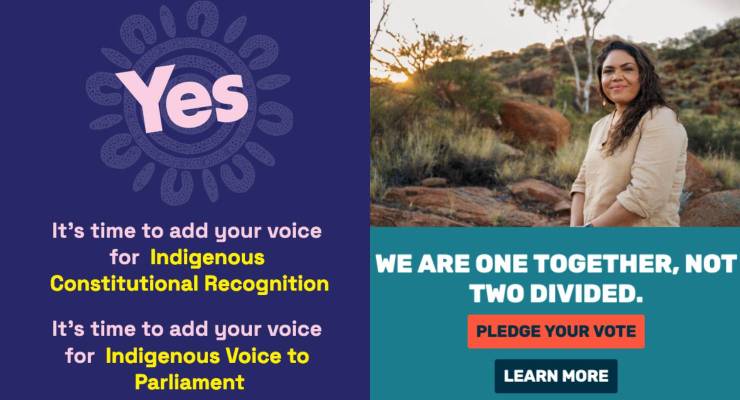
Yes campaigns for an Indigenous Voice to Parliament are outperforming the No opposition on social media as both sides begin targetting voters ahead of this year’s referendum.
With voters already making up their minds prior to the referendum — expected to take place between October and December — campaigns have already spent this year reaching undecided voters, firming up support, and winning over opponents.
Much of the discourse is being fought by individual politicians, parties and groups, but dedicated Voice campaigns are leading the charge.
Despite having 10 times fewer followers, ADVANCE’s No campaign Fair Australia and the Warren Mundine-led Recognise A Better Way slightly edge out the high-profile Australians for Indigenous Constitutional Recognition’s Yes23 and Uluru Statement from the Heart’s campaigns, when measured by the number of engagements using social media analysis tool CrowdTangle.
These No campaigns have racked up more than 61,000 engagements compared with the Yes campaign’s 57,000 engagements in the past three months. Measuring engagements (which includes likes, comments and shares) is a rough proxy for the number of views and a direct measure of how involved followers are with the page.
But this very slight advantage is significantly outweighed by the Yes campaign’s dominance on Instagram, where the No campaigns lack accounts. The Yes23 and Uluru Statement from the Heart’s accounts have had more than 88,000 engagements over the past three months. The only campaign to have a TikTok account is the Uluru Statement from the Heart, which has garnered 24,000 likes and grown its audience to 3200 followers since it launched.
Two campaigns have already begun supplementing their organic posts with paid advertising, according to Meta’s political ad library.
Yes23 has spent the most over the past 90 days, outlaying up to $26,000 to reach 2.8 million Facebook and Instagram users. The campaign’s advertising has primarily focused on people aged under 45 living in capital cities other than Darwin. They’ve also specifically targeted people on Facebook with interests such as volunteering, Indigenous art, charity and political-related topics, as well as people with post-secondary education.
Over the same period, more than $18,000 has been spent promoting Fair Australia’s case against the Voice to Parliament. It has specifically targeted some of its posts at residents of Western Australia, Queensland and South Australia, as well as at voters over 30.
While the audiences of these campaigns so far pale in comparison to the social media reach of established figures and groups who’ve taken sides on the debate (which may tilt in favour of the No campaign), the organised side pushing for the Voice to Parliament appears to have an early head start on those who oppose.








And so, like climate change, another great moral question of our time is degraded and debased into just another round of petty politicking.
Dutton must be called out for big lie “Canberra Voice” which is a huge insult to Indigenous communities all over Australia. Howard, Abbott and the monarchists look likely to repeat the DECEITFUL anti Republic campaign in 1999.
Reading this summary about social media messaging got me thinking that comparisons to the Republic referendum are misguided.
In 1999 the No case’s primary argument was that the current system is working fine so don’t mess with it, and that was supplemented with voters who wanted a different model to that proposed.
Today, the number of voters who think the current state of indigenous affairs is acceptable is small. The real battle is over the merits of the model. I think the change argument starts this campaign on a firmer footing.
Or am I being wildly optimistic?
The No campaign may be targeting the states which could vote against..
why bother with Vic, SA and NSW?
far fewer people to engage with in NT WA and Qld..
as for TAS..who knows?
early days yet..
NT is not a state
WA ( 68% ) and Tasmania ( 63% )appear to be well ahead in the ‘yes’ sides.
Nothing ventured nothing gained. At the moment we are all losing one way or another. Didn’t we prove back in the 80s or so that win win is the target for a better society? It’s a yes from me!